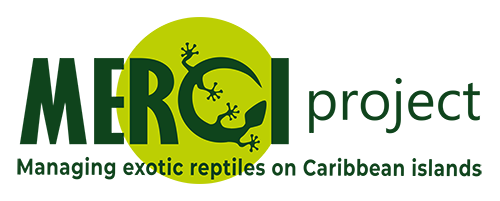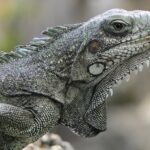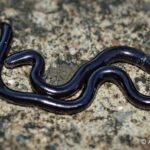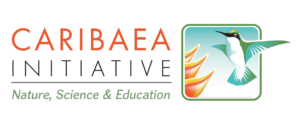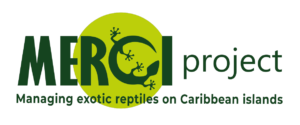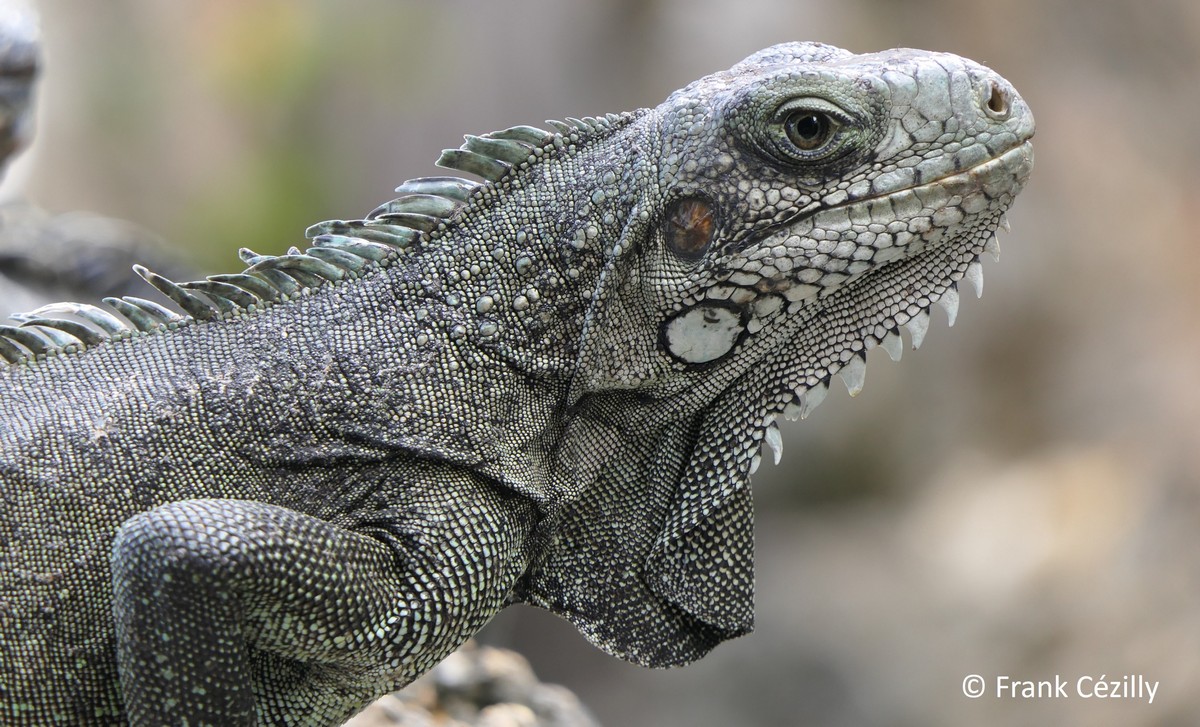
- Common name: Common Iguana, Green Iguana
- Nom scientifique : Iguana iguana (Linnaeus, 1758)
- Local name: Iguanas Verdes, Iguanes Communes, Garrobos, Guachos (Costa Rica), Iguanas de Agua, Iguanas Doradas, Shilianas (Guatemala), Iguanas de Ribera, Gallinas de Palo (Panama), Gwo Zandolois, Kwéyòl, Lézas (Sainte Lucie), Green Mexican Iguana, Iguane vert, Iguane
- Order : Iguanidae
- Family : Squamata
Description
Morphology. Large sized iguana, with a long tail that can be two to three times the length of the body. The phalanges are elongated, and the claws long and curved. A large serrated and spiky dewlap is present under the throat, as well as a crest of flexible thorns along the nape and back, to the beginning of the tail. These dorsal thorns, measuring over fifteen millimetres, are therefore larger than in most other Iguanidae, with the exception of Centrosaurus spp (Falcon et al., 2012). Iguana iguana is generally green, but can also present a great diversity of colours: black, grey, white, bluish, brown, or even orange during the breeding season. The colour is generally uniform, covered with darker patterns in the form of spots, dots and stripes. The tail is often marked with dark stripes. The iris colour varies from pale orange to dark brown (Breuil, 2013).
Standard body size (snout-vent length). males: 180 to 540 mm; females: 240 to 470 (Rand et al., 1989; Meshaka et al., 2007; Breuil, 2013; Lopez-Torres et al., 2012; Sanches, 2018).
Sexual dimorphism. Males are generally larger than females, and exhibit larger dorsal spines, jowls, and dewlap (Falcon et al. 2012). Males are also more vividly coloured than females.
Variations.
Possible confusion with other species. In the Caribbean, confusion is possible with several native species.
The Lesser Antilles iguana I. delicatissima, native to Antigua, Saint Barthélemy, Guadeloupe and Martinique, is mainly characterised by the absence of an enlarged sub-tympanic scale (Breuil, 2013; Vuillaume et al., 2015). The existence of hybrids, exhibiting intermediate traits between I. iguana and I. delicatissima, can make it difficult to distinguish between both species (Breuil, 2013; Vuillaume et al., 2015).
Iguana cf. iguana in Saint Lucia is characterised by fewer and less pronounced tubercles on the sides of the neck (Morton and Krauss, 2011; Breuil, 2013).
The blue iguana Cyclura lewisi from Grand Cayman, C. nubila caymanensis from Little Cayman and Cayman Brac, as well as C. cornuta stejnegeri from Puerto Rico are characterised by the absence of thorns on the edges of the dewlap, enlarged sub-tympanic scales, and stripes on the tail.
In the Fiji, the three native species of the genus Brachylophus also lack enlarged sub-tympanic scales and spines along the dewlap (Falcon et al., 2012).
Distribution
Native. Mexico, Nicaragua, Guatemala, Belize, Salvador, Honduras, Costa Rica, Panama, Colombia, Ecuador, Venezuela, Guyana, Surinam, Guyane, Brazil, Peru, Bolivia, Paraguay (Buckley et al., 2016).
Caribbean: Trinidad (Krysko et al., 2007; Auguste, 2019, 2020), Tobago (Krysko et al., 2007; Auguste, 2019, 2020), Tortuga, San Andrés, Providence island, Swan island.
Introduced. Hawai (Buckley et al., 2016), Florida (Townsend et al., 2003; Krysko et al., 2007), Canarias (Buckley et al., 2016), Thailande (van den Burg et al., 2020a), Singapore (van den Burg et al., 2020a), Taiwan (Lee et al., 2019), Japan (Falcon et al., 2012), Fiji (Thomas et al., 2013; Shah et al., 2020).
Several individuals observed in different localities in Israel, but no established breeding population (Shacham and Nemtzov, 2008).
Caraïbes: Cayman islands, Dominican Republic (Buckley et al., 2016), Desecheo, Puerto Rico, American and British Virgin Islands, Anguilla (Buckley et al., 2016), Saint Martin (Breuil et al., 2019), Saint Eustatius (van den Burg, 2018), Saint Barthélemy (Breuil et al., 2019), Barbuda (Lindsay et Mussington, 2009), Antigua (Lindsay and Mussington, 2009), Montserrat (Buckley et al., 2016), Guadeloupe (Breuil et al., 2019), Dominica (van den Burg et al., 2020b), Martinique (Breuil et al., 2019), Saint Lucia (Breuil et al., 2019), Saint Vincent and the Grenadines (Breuil et al., 2019), Grenada (Breuil et al., 2019).
Several individuals observed in the Andros archipelago (Bahamas) since 2016, but the establishement of breeding populations remains to be confirmed (Johnson, 2020).
Biology and ecology
Habitat. Iguana iguana inhabit is usually found in dry (desert areas, steppes) or mesic habitats, up to 1000 meters of altitude, but is also present in mangroves and beaches (Swierk and Langkilde, 2009). In dry environments, the Green iguana is terrestrial, finding refuge in burrows or cracks. In forest environments, the species is generally arboreal. I. iguana is also observed in anthropized environments, sheltering in conduits or ditches (Krysko et al. 2007).
Diet. Herbivore, and occasionally insectivore (Rand et al., 1990; Arce-Nazario and Carlo, 2012).
Reproduction. Reproduction and nesting happen during the dry season, and hatching occurs about three months later, between the end of the dry season and the beginning of the wet season (Townsend et al. 2003). The eggs are deposited in a burrow dug by the female (Rand and Dugan, 1983; Bock and Rand, 1989). Several females may deposit their eggs in the same burrow, in different chambers, forming a complex underground network of interconnected tunnels up to 24 meters with several openings (Rand, 1968; Rand and Dugan 1983). Females can lay eggs at sites several kilometres away from their home range (Bock et al. 1989; Rand et al. 1989). The number of eggs laid by a female varies greatly, between 14 and 76 eggs (Avery and Tanner 1971).
Behaviour. The dewlap is used for inter-specific visual communication (Dugan, 1982).
The tail can be used defensively, like a whip.
Impact and management of introduced populations
Impact. The introduction of the Green iguana outside its native range primarily impacts native iguana species through competition and hybridisation pressure. In Saint Eustatius, Saint Barthélemy and in the Guadeloupe archipelago, the populations of the Lesser Antilles iguana Iguana delicatissima are thus significantly affected by the introduction of the Green iguana (Breuil et al., 2009, 2019; Vuillaume et al. , 2015; van den Burg, 2018). The species is therefore also considered to be a threat for the populations of Iguana cf. iguana in Saint Lucia and Cyclura lewisi in Grand Cayman.
I. iguana is suspected of using the burrows of the Florida Burrowing Owl, Athene cunicularia floridana (McKie et al. 2005).
The Green iguana is also a vector of parasites, in particular the tick Amblyomma sabanerae transmissible to several species of sea and land turtles, and snakes (Falcon et al., 2012).
I. iguana actively participates in the dispersal of seeds over its native range (Moura et al., 2015), and can thus facilitate the introduction of plant species outside their native range, such as the pepper tree Schinus terebinthifolia in Puerto Rico (Sementelli et al., 2008; Falcon et al., 2012).
Management. The species is subject to a significant management and control effort, including regular eradication campaigns in Florida, on some Caribbean islands and in Fiji (Thomas et al., 2013; Krauss, 2013; Krauss et al., 2013; Krauss, 2013; Krauss et al. al., 2014; Angin, 2017; Rateau et al., 2021). In the Caribbean, the main objective of these efforts is the preservation of endemic iguana species, such as the Lesser Antilles iguana I. delicatissima in Guadeloupe and Martinique (Legouez, 2010), and the Saint Lucia iguana I. cf . iguana.
Bibliographie
- Angin, B. (2017). Plan national d’ actions pour le rétablissement de l’iguane des petites Antilles, Iguana delicatissima, 2018-2022.
- Arce-Nazario, J. A., & Carlo, T. A. (2012). Iguana iguana invasion in Puerto Rico: Facing the evidence. Biological Invasions, 14, 1981–1984.
- Auguste, R. J. (2019). Herpetofaunal checklist for six pilot protected areas in Trinidad and Tobago. Herpetology Notes, 12, 577–585.
- Auguste, R. J. (2020). Using citizen science to rapidly determine the distribution of exploited green iguanas (Iguana iguana) across urban areas in Trinidad and Tobago. Reptiles & Amphibians, 27, 419–421.
- Avery, D. F., & Tanner, W. W. (1971). Evolution of the iguanine lizards (Sauria, Iguanidae) as determined by osteological and myological characters. Brigham Young University Science Bulletin, Biological Series, 12, 1971.
- Bock, B. C., & Rand, A. S. (1989). Factors influencing nesting synchrony and hatching success at a Green Iguana nesting aggregation in Panama. Copeia, 4, 978-986.
- Bock, B. C., Rand, A. S., & Burghardt, G. M. (1989). Nesting season movements of male Green Iguanas (Iguana iguana) in Panama. Copeia, 1, 214–216.
- Breuil, M. (2013). Caractérisation morphologique de l’iguane commun Iguana iguana (Linnaeus, 1758), de l’iguane des Petites Antilles Iguana delicatissima (Laurenti, 1768) et de leurs hybrides. Bulletin de La Société Herpétologique de France, 147, 309–346.
- Breuil, M., Guiougou, F., Questel, K., & Ibéné, B. (2009). Modifications du peuplement herpétologique dans les Antilles françaises : disparitions et espèces allochtones. 2ème partie : Reptiles. Le Courrier de La Nature, 251, 36–43.
- Breuil, M., Vuillaume, B., Schikorski, D., Krauss, U., Morton, M. N., Haynes, P., … Grandjean, F. (2019). A story of nasal horns: two new subspecies of. Zootaxa, 4608, 201–232.
- Buckley, L. J., De Queiroz, K., Grant, T. D., Hollingsworth, B. D., Iverson, J. B., Pasachnik, S. A., & Stephen, C. L. (2016). A checklist of the Iguanas of the world (Iguanidae; Iguaninae). Herpetological Conservation and Biology, 11, 4–46.
- Dugan, B. (1982). A field study of the headbob displays of male green iguanas (Iguana iguana): Variation in form and context. Animal Behaviour, 30, 327–338.
- Falcon, W., Ackerman, J. D., & Daehler, C. C. (2012). March of the Green Iguana: non-native distribution and predicted geographic range of Iguana iguana in the Greater Caribbean region. IRCF Reptiles and Amphibians, 19, 150–160.
- Johnson, S. (2020). First record of a Green Iguana (Iguana iguana) on Andros (Bahamas): a potential threat to endemic Bahamian Rock iguanas. Reptiles & Amphibians, 26, 255–256.
- Krauss, U. (2013). Invasive Alien Species management in St. Lucia and Caribbean partner countries. Biodiversité Insulaire, 196.
- Krauss, U., Isidore, L., Mitchel, N., Seely, L., Alfred, P., Ramessar, A., … Bobb, M. (2014). An assessment of control methods for Invasive Alien Iguanas in Saint Lucia.
- Krysko, K. L., Enge, K. M., Donlan, E. M., Seitz, J. C., & Golden, E. A. (2007). Distribution, natural history, and impacts of the introduced Green iguana (Iguana iguana) in Florida. Iguana, 14, 142–151.
- Lee, K. H., Chen, T. H., Shang, G., Clulow, S., Yang, Y. J., & Lin, S. M. (2019). A check list and population trends of invasive amphibians and reptiles in Taiwan. ZooKeys, 2019, 85–130.
- Legouez, C. (2010). Plan National d’Actions en faveur de l’iguane des petites Antilles (Iguana delicatissima) 2011-2015.
- Lindsay, K., & Mussington, J. (2009). Iguana iguana in Antigua and Barbuda, West Indies. Applied Herpetology, 6, 189–190.
- López-Torres, A. L., Claudio-Hernández, H. J., Rodríguez-Gómez, C. A., Longo, A. V., & Joglar, R. L. (2012). Green Iguanas (Iguana iguana) in Puerto Rico: Is it time for management? Biological Invasions, 14, 35–45.
- McKie, A. C., Hammond, J. E., Smith, H. T., & Meshaka, W. E. (2005). Invasive Green Iguana interactions in a Burrowing Owl colony in Florida. Florida Field Naturalist, 33, 125–127.
- Meshaka Jr, W. E., Smith, H. T., Golden, E., Moore, J. A., Fitchett, S., Cowan, E. M., … Cress, H. L. (2007). Green Iguanas (Iguana Iguana): the unintended consequence of sound wildlife management practices in a South Florida park. Wildlife Research, 2, 149–156.
- Morton, M. N., & Krauss, U. (2011). Native and alien iguanas on Saint Lucia, West Indies. IRCF Reptiles and Amphibians, 18, 25–31.
- Moura, A. C. de A., Cavalcanti, L., Leite-Filho, E., Mesquita, D. O., & Mcconkey, K. R. (2015). Can green iguanas compensate for vanishing seed dispersers in the Atlantic forest fragments of north-east Brazil? Journal of Zoology, 295, 189–196.
- Rand, A. S. (1968). A Nesting Aggregation of Iguanas. Copeia, 3, 552–561.
- Rand, A. S., & Dugan, B. (1983). Structure of Complex Iguana Nests. Copeia, 1983, 705.
- Rand, A. S., Dugan, B. A., Monteza, H., & Vianda, D. (1990). Society for the Study of Amphibians and Reptiles The Diet of a Generalized Folivore: Iguana iguana in Panama. Source: Journal of Herpetology, 24, 211–214.
- Rand, A. S., Font, E., Ramos, D., I-Werner, D., & Bock, B. C. (1989). Home range in Green Iguanas (Iguana iguana) in Panama. Copeia, 1, 217–221.
- Rateau, F., Gresser, J., Singh, C., Bonanno, A., Rizzi, M.-L., & Courty, C. (2021). Régulation de l’Iguane rayé en Martinique.
- Sanches, V. Q. A., & Grings, D. R. (2018). Daily movement and habitat use of Iguana iguana (Linnaeus, 1758) in an urban second growth Amazonian forest fragment in Brazil. Herpetology Notes, 11, 93–96.
- Sementelli, A., Smith, H. T., Meshaka, W. E., & Engeman, R. M. (2008). Just Green Iguanas? The associated costs and policy implications of exotic invasive wildlife in South Florida. Public Works Management & Policy, 12, 599–606.
- Shacham, B., & Nemtzov, S. C. (2008). Records of feral green iguana, Iguana iguana, in Israel. Applied Herpetology, 5, 99.
- Shah, S., Dayal, S. R., Bhat, J. A., & Ravuiwasa, K. (2020). Green Iguanas: a threat to man and wild in Fiji Islands? International Journal of Conservation Science, 11, 765–782.
- Swierk, L. N., & Langkilde, T. (2009). Micronutrient input into a mangrove ecosystem in Jobos Bay, Puerto Rico, by the exotic green iguana Iguana iguana. Current Zoology, 55, 50–53.
- Thomas, N., NatureFiji-MareqetiViti, S., Mataitoga;, W., Blossom;, T., Qeteqete;, S., Surumi;, J., … Veen, R. Van. (2013). Emergency response to introduced Green Iguanas in Fiji. Apia, Samoa.
- Townsend, J. H., Krysko, K. L., & Enge, K. M. (2003). Introduced Iguanas in Southern Florida: a history of more than 35 years. Iguana: Journal of the International Iguana Society, 10, 111–118.
- van den Burg, M. P., Meirmans, P. G., Wagensveld, T. van, Kluskens, B., Madden, H., Welch, M. E., & Breeuwer, J. A. J. (2018). The Lesser Antillean (Iguana delicatissima) on St. Eystatius: genetically depauperate and threatened by ongoing hybridization. Journal of Heredity, 2, 1–27.
- van den Burg, M. P., Van Belleghem, S. M., & Villanueva, C. N. D. J. (2020a). The continuing march of Common Green Iguanas: arrival on mainland Asia. Journal for Nature Conservation, 57(August), 125888.
- van den Burg, M. P., Brisbane, J. L. K., & Knapp, C. R. (2020b). Post-hurricane relief facilitates invasion and establishment of two invasive alien vertebrate species in the Commonwealth of Dominica, West Indies. Biological Invasions, 22, 195–203.
